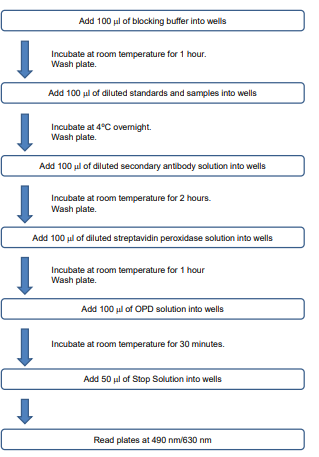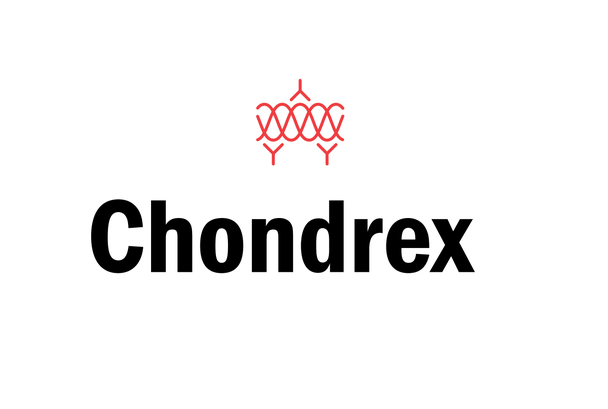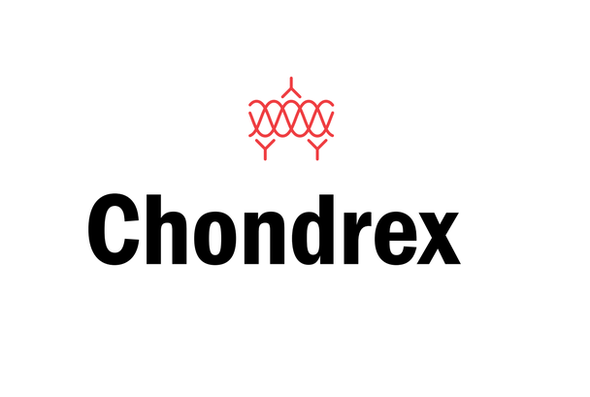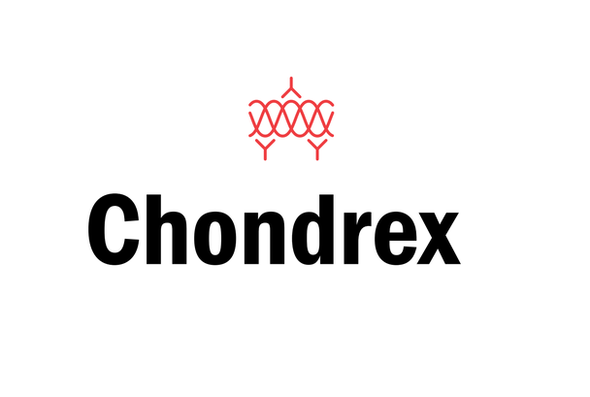Human/Monkey Anti-Bovine Type I Collagen IgA Antibody Assay Kit, TMB
- SKU:
- 445-1042T
- Size:
- 1 kit
- Shipping:
- Gel Packs
- Storage:
- -20 C
Description
Human/Monkey Anti-Bovine Type I Collagen IgA Antibody Assay Kit, TMB - Cat Number: 1042T From Chondrex.
Research Field: Arthritis, Immunology
Clonality: N/A
Cross-Reactivity:
Host Origin: N/A
Applications: N/A
Isotype: N/A
Detection Range: 16 units/ml-0.25 units/ml
Sample Type: Serum, Plasma
Concentration: N/A
Immunogen:
PRODUCT SPECIFICATIONS
DESCRIPTION: Assay kit to quantify human/monkey anti-collagen antibodies
FORMAT: Pre-coated 96-well ELISA Plate with removeable strips
ASSAY TYPE: Indirect ELISA
ASSAY TIME: 5.25 hours
STANDARD RANGE: 16 units/ml to 0.25 units/ml
NUMBER OF SAMPLES: Up to 38 (duplicate) samples/standard plate (will vary for custom kits)
SAMPLE TYPES: Serum and Plasma
RECOMMENDED SAMPLE DILUTIONS: 1:100 (at least)
CHROMOGEN: TMB (read at 450 nm)
STORAGE: -20°C
VALIDATION DATA: N/A
NOTES:
INTRODUCTION
Human serum, especially from patients with autoimmune diseases, contain high levels of immunoreactive components, which yield high
background levels in ELISA systems. These non-specific reactions are caused by adhesive immunoglobulins in human serum which so
strongly adhere to plastic surfaces by hydrophilic binding that blocking agents such as bovine serum albumin (BSA) and Tween 20 are not
capable of blocking these non-specific reactions at all. False positive reactions caused by the serum samples themselves are usually
overlooked and are considered real antibody-antigen reactions in many cases, even now. In order to obtain the real values of antigenantibody reactions, it is critical 1) to choose proper blocking agents which block these kinds of non-specific reactions effectively, 2) to
determine the unique non-specific background value of each individual sample using antigen-non-coated wells, and 3) to subtract that
background value from the corresponding value determined in antigen-coated wells. In addition, it is important to determine the non-specific
reactions caused by the secondary antibody as well. Chondrex, Inc.’s ELISA system incorporates unique blocking agents that inhibit the
hydrophobic binding of these serum components onto plastic surfaces and are designed to determine the background values of individual
samples using antigen-non-coated wells.
IgA antibodies to type II collagen are often associated with IgG antibodies in human serum. Importantly, IgA and IgG antibodies share
identical collagen types and species specificity in individual serum, suggesting that the same collagen is involved in eliciting these antibodies.
Therefore, it is highly likely that heterologous collagen in diets may play a primary role in the anti-collagen antibody production, regardless
of the disease. However, this does not mean that type II collagen is always the eliciting antigen as type I collagen, commonly found in diets,
share’s over 80% of its amino acid sequence with that of type II collagen, and the antibodies in human serum often react to both type I and
type II collagen. To determine the diversity of anti-collagen antibodies in human serum, Chondrex, Inc. provides IgA and IgG antibody ELISA
kits with various species of type I and type II collagen-coated strips as well as uncoated wells. This ELISA kit contains enough materials to
run two plates on two separate occasions and may be used for monkey serum as well as human serum.
NOTE: Because IgA and IgG antibodies in human sera share similar collagen types and species of specificity, it is assumed that IgA
antibodies determined by this ELISA kit might be underestimated due to the competitive binding of IgG antibodies to the identical epitopes
on collagen molecules. In order to accurately determine IgA antibody levels in human serum samples, Chondrex, Inc. recommends treating
serum samples with Protein G to remove IgG antibodies.
PLATE COATING AND SETUP

Standard ELISA Kit with One Species of Type I or Type II Collagen
A standard ELISA kit consisting of five 8-well strips which are uncoated
and serve as a control for background levels of individual samples, five 8-
well strips coated with one species of type I or type II collagen to
determine specific antibody levels, and two 8-well strips for reference
standards. “B” represents blank wells to determine non-specific reactions
caused by the secondary antibody. Standards and samples are run in
duplicate.
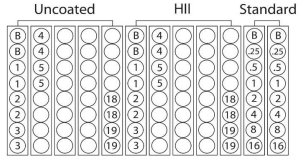
Custom ELISA Kit with Multiple Species of Collagen
A custom kit for assaying antibody levels to various species of type I or
type II collagen in human serum. This custom ELISA plate consists of two
uncoated 8-well strips, two each of 8-well strips coated with chick (CII),
bovine (BII) and human (HII) type II collagen, as well as bovine (BI) type I
collagen and two 8-well strips for reference standards. “B” represents
blank wells to determine non-specific reactions caused by the secondary
antibody.

KIT COMPONENTS
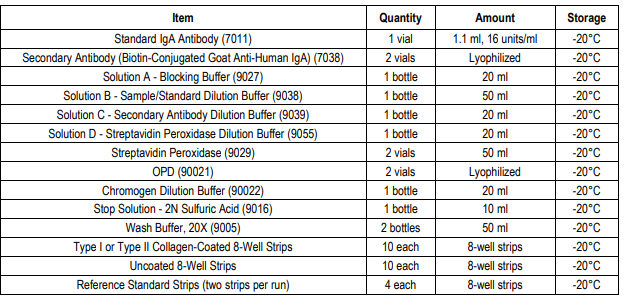
NOTES BEFORE USING ASSAY
NOTE 1: It is recommended that the standard and samples be run in duplicate.
NOTE 2: Warm up all buffers to room temperature before use.
NOTE 3: Crystals may form in Wash Buffer, 20X when stored at cold temperatures. If crystals have formed, warm the wash buffer by placing
the bottle in warm water until crystals are completely dissolved.
NOTE 4: Measure exact volume of buffers using a serological pipet, as extra buffer is provided.
NOTE 5: Cover the plate with plastic wrap or a plate sealer after each step to prevent evaporation from the outside wells of the plate.
NOTE 6: For partial reagent use, please see the assay protocol’s corresponding step for the appropriate dilution ratio. For example, if the
protocol dilutes 50 µl of a stock solution in 10 ml of buffer for 12 strips, then for 6 strips, dilute 25 µl of the stock solution in 5 ml of buffer.
Partially used stock reagents may be kept in their original vials and stored at -20⁰C for use in a future assay.
NOTE 7: This kit contains animal components from non-infectious animals and should be treated as potential biohazards in use and for
disposal.
ASSAY OUTLINE
